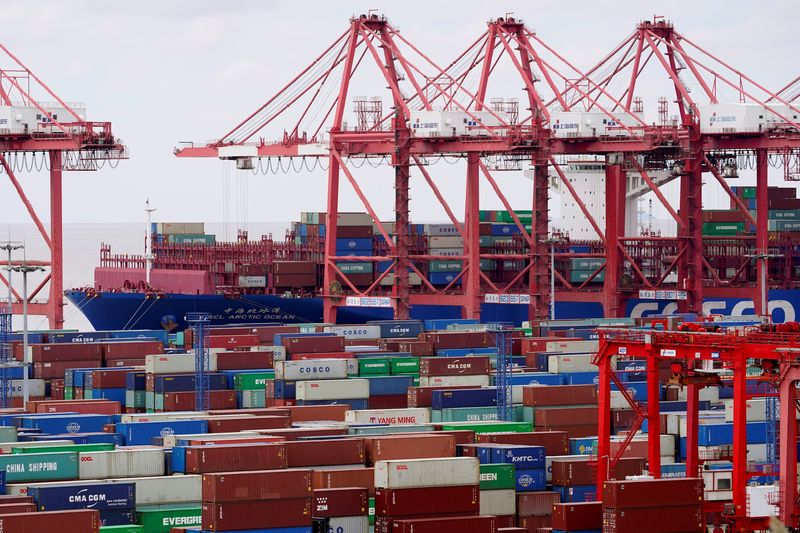Economy
Analysis-No decoupling, but West and China drift apart


© Reuters. FILE PHOTO: Containers are seen at the Yangshan Deep Water Port in Shanghai, China, as the coronavirus disease (COVID-19) outbreak continues, October 19, 2020. REUTERS/Aly Song/File Photo
By Mark John
(Reuters) – China’s unexpectedly poor export performance as revealed on Tuesday is still largely down to wider economic headwinds. But underlying trade and investment trends point to an unmistakable long-term drift in commercial ties with the West.
Official data showed a 14.5% drop in July exports amid weak consumer demand in the world markets served by China – the fastest decline since the pandemic hit in 2020. Lower imports meanwhile highlighted the lacklustre domestic Chinese picture.
For now, such cyclical factors outweigh any impact of calls by Western governments for companies to “de-risk” supply chains as a new era of distrust prompts the United States and Europe to cut trade reliance in strategic sectors with China.
But the longer-term direction of travel emerges more clearly as you pan out from the monthly trade headline.
Take foreign direct investment – the more forward-looking clue as to where commercial ties between countries are heading.
Foreign investment into China fell to around 0.4% of output by the end of June compared to an average of 1.6% for the five years before the pandemic – a 67% real decline over the period to the lowest level since records began 25 years ago.
“We would expect that to recover with the reopening but that really hasn’t been the case,” said Louise Loo, senior economist with Oxford Economics.
“That is more of a geopolitical story because of the regulatory environment, because of what is happening on the supply chain side,” she added of regulatory crackdowns on some sectors that have unnerved potential investors.
WATCH GERMANY
Some, meanwhile, point to the fact that U.S.-China trade – exports and imports of goods combined – hit a record $690 billion last year as evidence that the reality does not match the frosty political rhetoric.
But Stephen Roach, senior fellow at Yale Law School’s Paul Tsai China Center, noted that such tallies were expressed in dollars unadjusted for surging inflation and came at a time when overall output was dragging many indicators higher.
In fact, he calculated, US-China bilateral trade in goods and services in real terms fell to 3% of U.S. output in 2022 from a peak of 3.7% in 2014 – a decline of about a fifth.
“While this is a far cry from full decoupling … it certainly qualifies as a meaningful step in that direction,” he wrote in a column last month.
The picture in Europe is more mixed but clearly visible in the trade data of Germany, which under former chancellor Angela Merkel nurtured strong commercial ties with China that helped turbo-charge its economy through the 2000s and beyond.
According to official data accessed by Reuters last week, exports to China made up just 6.2% of total German exports in the first half of the year – the lowest share since 2016.
The fact that China is no longer the market it was for German exporters has less to do with de-risking and is more likely a consequence of China increasingly able to produce goods it previously had to buy from Germany, analysts noted.
Last month’s China strategy document unveiled by Chancellor Olaf Scholz’s three-way coalition left open exactly how far Berlin would ultimately go in reining in commercial ties.
Mark Leonard of the European Council on Foreign Relations said the German stance was critical given that four German firms – Mercedes-Benz, BMW, Volkswagen (ETR:), and BASF – accounted for a third of all European investment in China between 2018 and 2021.
“The stakes are high, because where Germany goes, the rest of Europe often follows,” he wrote in a July 28 commentary.
The trade environment could be about to get frostier.
U.S. President Joe Biden is expected in coming days to issue his long-awaited executive order to screen outbound investments in sensitive technologies to China, according to people familiar with the matter.
As campaigning for elections next year in United States and Taiwan gets going, U.S. foreign policy could turn more hawkish, Oxford Economics’ Loo noted of a further development that could weigh further on China’s trading outlook.
“Our conviction around a near-term possibility of a more predictable and transparent framework for US-China relations remains low,” she said.
(Writing and reporting by Mark John; editing by Christina Fincher)
Economy
Russian central bank says it needs months to make sure CPI falling before rate cuts -RBC


© Reuters. Russian Central Bank Governor Elvira Nabiullina attends a news conference in Moscow, Russia June 14, 2019. REUTERS/Shamil Zhumatov/File Photo
MOSCOW (Reuters) – Russia’s central bank will need two to three months to make sure that inflation is steadily declining before taking any decision on interest rate cuts, the bank’s governor Elvira Nabiullina told RBC media on Sunday.
The central bank raised its key interest rate by 100 basis points to 16% earlier in December, hiking for the fifth consecutive meeting in response to stubborn inflation, and suggested that its tightening cycle was nearly over.
Nabiullina said it was not yet clear when exactly the regulator would start cutting rates, however.
“We really need to make sure that inflation is steadily decreasing, that these are not one-off factors that can affect the rate of price growth in a particular month,” she said.
Nabiullina said the bank was taking into account a wide range of indicators but primarily those that “characterize the stability of inflation”.
“This will take two or three months or more – it depends on how much the wide range of indicators that characterize sustainable inflation declines,” she said.
The bank will next convene to set its benchmark rate on Feb. 16.
The governor also said the bank should have started monetary policy tightening earlier than in July, when it embarked on the rate-hiking cycle.
Economy
China identifies second set of projects in $140 billion spending plan


© Reuters. FILE PHOTO: Workers walk past an under-construction area with completed office towers in the background, in Shenzhen’s Qianhai new district, Guangdong province, China August 25, 2023. REUTERS/David Kirton/File Photo
SHANGHAI (Reuters) – China’s top planning body said on Saturday it had identified a second batch of public investment projects, including flood control and disaster relief programmes, under a bond issuance and investment plan announced in October to boost the economy.
With the latest tranche, China has now earmarked more than 800 billion yuan of its 1 trillion yuan ($140 billion) in additional government bond issuance in the fourth quarter, as it focuses on fiscal steps to shore up the flagging economy.
The National Development and Reform Commission (NDRC) said in a statement on Saturday it had identified 9,600 projects with planned investment of more than 560 billion yuan.
China’s economy, the world’s second largest, is struggling to regain its footing post-COVID-19 as policymakers grapple with tepid consumer demand, weak exports, falling foreign investment and a deepening real estate crisis.
The 1 trillion yuan in additional bond issuance will widen China’s 2023 budget deficit ratio to around 3.8 percent from 3 percent, the state-run Xinhua news agency has said.
“Construction of the projects will improve China’s flood control system, emergency response mechanism and disaster relief capabilities, and better protect people’s lives and property, so it is very significant,” the NDRC said.
The agency said it will coordinate with other government bodies to make sure that funds are allocated speedily for investment and that high standards of quality are maintained in project construction.
($1 = 7.1315 renminbi)
Economy
Russian central bank says it needs months to make sure CPI falling before rate cuts -RBC


© Reuters. Russian Central Bank Governor Elvira Nabiullina attends a news conference in Moscow, Russia June 14, 2019. REUTERS/Shamil Zhumatov/File Photo
MOSCOW (Reuters) – Russia’s central bank will need two to three months to make sure that inflation is steadily declining before taking any decision on interest rate cuts, the bank’s governor Elvira Nabiullina told RBC media on Sunday.
The central bank raised its key interest rate by 100 basis points to 16% earlier in December, hiking for the fifth consecutive meeting in response to stubborn inflation, and suggested that its tightening cycle was nearly over.
Nabiullina said it was not yet clear when exactly the regulator would start cutting rates, however.
“We really need to make sure that inflation is steadily decreasing, that these are not one-off factors that can affect the rate of price growth in a particular month,” she said.
Nabiullina said the bank was taking into account a wide range of indicators but primarily those that “characterize the stability of inflation”.
“This will take two or three months or more – it depends on how much the wide range of indicators that characterize sustainable inflation declines,” she said.
The bank will next convene to set its benchmark rate on Feb. 16.
The governor also said the bank should have started monetary policy tightening earlier than in July, when it embarked on the rate-hiking cycle.

 Forex2 years ago
Forex2 years agoForex Today: the dollar is gaining strength amid gloomy sentiment at the start of the Fed’s week

 Forex2 years ago
Forex2 years agoHow is the Australian dollar doing today?

 Forex1 year ago
Forex1 year agoUnbiased review of Pocket Option broker

 Forex2 years ago
Forex2 years agoDollar to pound sterling exchange rate today: Pound plummeted to its lowest since 1985

 Cryptocurrency2 years ago
Cryptocurrency2 years agoWhat happened in the crypto market – current events today

 World2 years ago
World2 years agoWhy are modern video games an art form?

 Stock Markets2 years ago
Stock Markets2 years agoMorgan Stanley: bear market rally to continue

 Economy2 years ago
Economy2 years agoCrude oil tankers double in price due to EU anti-Russian sanctions

































